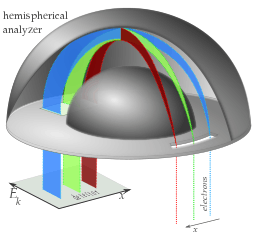Hemispherical electron energy analyzer
A hemispherical electron energy analyzer or hemispherical deflection analyzer is a type of electron energy spectrometer generally used for applications where high energy resolution is needed—different varieties of electron spectroscopy such as angle-resolved photoemission spectroscopy (ARPES), X-ray photoelectron spectroscopy (XPS) and Auger electron spectroscopy (AES)[1] or in imaging applications such as photoemission electron microscopy (PEEM) and low-energy electron microscopy (LEEM).[2]

Function

An ideal hemispherical analyzer consists of two concentric hemispherical electrodes (inner and outer hemispheres) of radii and held at proper voltages. In such a system, the electrons are linearly dispersed, depending on their kinetic energy, along the direction connecting the entrance and the exit slit, while the electrons with the same energy are first-order focused.[3]
When two voltages, and , are applied to the inner and outer hemispheres, respectively, the electric potential in the region between the two electrodes follows from the Laplace equation:
The electric field, pointing radially from the center of the hemishperes out, has the familiar planetary motion form
The voltages are set in such a way that the electrons with kinetic energy equal to the so-called pass energy follow a circular trajectory of radius .The centripetal force along the path is imposed by the electric field . With this in mind,
- ,
The potential difference between the two hemispheres needs to be
- .
A single detector at radius on the other side of the hemispheres will register only the electrons of a single kinetic energy. The detection can, however, be parallelized because of nearly linear dependence of the final radii on the kinetic energy. In the past, several discrete electron detectors (channeltrons) were used, but now microchannel plates with phosphorescent screens and camera detection prevail.


In general, these trajectories are described in polar coordinates for the plane of the great circle for electrons impinging at an angle with respect to the normal to the entrance, and for the initial radii to account for the finite aperture and slit widths (typically 0.1 to 5 mm):[4]
where .
As can be seen in the pictures of calculated electron trajectories, the finite slit width maps directly into energy detection channels (thus confusing the real energy spread with the beam width). The angular spread, while also worsening the energy resolution, shows some focusing as the equal negative and positive deviations map to the same final spot.

When these deviations from the central trajectory are expressed in terms of the small parameters defined as , , and having in mind that itself is small (of the order of 1°), the final radius of the electron's trajectory, , is given by
.
This means that to the energy dispersion of a smearing of is added at every point of the detector. This smearing is thus confused for the true energy dispersion . It follows that the instrumental energy resolution, given as a function of the average width of the two slits and the maximal incidence angle of the incoming photoelectrons, which is itself dependent on , is
- .
The resolution improves with increasing . However, technical problems related to the size of the analyzer put a limit on its actual value, and most analyzers have it in the range of 100-200 mm. Lower pass energies also improve the resolution, but then the electron transmission probability is reduced, and the signal-to-noise ratio deteriorates accordingly. The electrostatic lenses in front of the analyzer have two main purposes: they collect and focus the incoming photoelectrons into the entrance slit of the analyzer, and they decelerate the electrons to the range of kinetic energies around , in order to increase the resolution.
When acquiring spectra in swept (or scanning) mode, the voltages of the two hemispheres – and hence the pass energy – are held fixed; at the same time, the voltages applied to the electrostatic lenses are swept in such a way that each channel counts electrons with the selected kinetic energy for the selected amount of time. In order to reduce the acquisition time per spectrum, the so-called snapshot (or fixed) mode can be used. This mode exploits the relation between the kinetic energy of a photoelectron and its position inside the detector. If the detector energy range is wide enough, and if the photoemission signal collected from all the channels is sufficiently strong, the photoemission spectrum can be obtained in one single shot from the image of the detector.
See also
References
- Roy, D.; Tremblay, D. (1990). "Design of electron spectrometers". Reports on Progress in Physics. 53 (12): 1621–1674. Bibcode:1990RPPh...53.1621R. doi:10.1088/0034-4885/53/12/003. ISSN 0034-4885.
- Tusche, Christian; Chen, Ying-Jiun; Schneider, Claus M.; Kirschner, Jürgen (2019-11-01). "Imaging properties of hemispherical electrostatic energy analyzers for high resolution momentum microscopy". Ultramicroscopy. 206: 112815. doi:10.1016/j.ultramic.2019.112815. ISSN 0304-3991. PMID 31325896.
- Hadjarab, F.; J.L. Erskine (1985). "Image properties of the hemispherical analyzer applied to multichannel energy detection". Journal of Electron Spectroscopy and Related Phenomena. 36 (3): 227. doi:10.1016/0368-2048(85)80021-9.
- Practical surface analysis : by auger and x-ray photoelectron spectroscopy. Briggs, D. (David), 1948-, Seah, M. P. Chichester: Wiley. 1983. ISBN 0-471-26279-X. OCLC 9556397.CS1 maint: others (link)